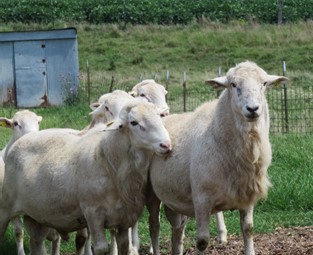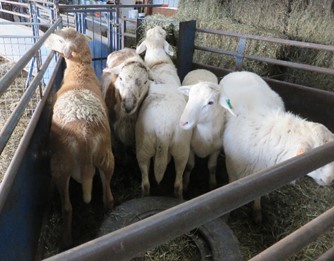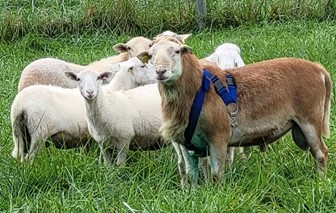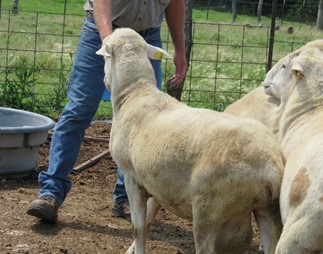 As sheep producers, we all need two important things to get lambs on the ground: ewes and at least one ram, depending on the size of the ewe flock. The purchase of a quality ram can be quite an investment. Understanding proper management and handling of your ram is vital to keeping the producer and everyone on the farm safe, while ensuring the health and longevity of the ram. Here are some points to think about in your operation:
As sheep producers, we all need two important things to get lambs on the ground: ewes and at least one ram, depending on the size of the ewe flock. The purchase of a quality ram can be quite an investment. Understanding proper management and handling of your ram is vital to keeping the producer and everyone on the farm safe, while ensuring the health and longevity of the ram. Here are some points to think about in your operation:
-
Proper handling and raising of rams/ram lambs impacts ram aggression. Rams have a natural level of aggression which increases as they reach puberty and become young adults. Proper handling should be a key factor to eliminate any learned aggression. Ram lambs tend to be friendlier than ewe lambs, but resist the idea of raising your ram as a pet. Do not encourage or challenge a ram or ram lamb by petting, pushing, scratching, etc., especially on the head or face. Discourage rams and ram lambs that want to rub on you or show any overly friendly behavior, but don’t be abusive. Never tease or play with a ram. A ram does best when raised with other sheep so he can learn appropriate flock behavior. Hand raised ram lambs (bottle lambs) are not good candidates for breeding stock as they are too comfortable around humans and have no established boundaries. This may not be obvious when the ram is young – they may simply appear to be friendly – but as they mature they can become unpredictable and dangerous. Once a ram has an aggressive pattern, it is very difficult to stop it!
Pen or house the ram with another animal, ideally a ram or wether, for company. Sheep, even rams, are flock animals and do best with a buddy. Rams will fight, sometimes to the death, to establish dominance, so proper introduction and monitoring are important. Two rams will fight more than a group of three or more. A ram and wether do well together, or two rams and a wether.
 The closer the rams are in age and size, the more intense the fighting. To introduce new rams, or reintroduce rams after breeding, confine them in a tight space until they stop fighting. Gradually increase the space allowed over a period of days. This keeps them from backing up and charging, greatly reducing the potential for injury or death. If you don’t have a small enough area, a trailer can work, or put down old tires in the pen.
The closer the rams are in age and size, the more intense the fighting. To introduce new rams, or reintroduce rams after breeding, confine them in a tight space until they stop fighting. Gradually increase the space allowed over a period of days. This keeps them from backing up and charging, greatly reducing the potential for injury or death. If you don’t have a small enough area, a trailer can work, or put down old tires in the pen.
Be prepared to have adequate fencing to confine your ram as he can become rambunctious during seasons when the ewes are cycling and you may not want a ram in with them yet. One of the best ways to stay safe around a ram is to limit close contact with the ram group, especially during breeding seasons, when your ram’s aggressive behavior is naturally heightened. Feeding and caring for your rams without entering the pens will reduce confrontations and keep everyone safer.
 Be safe when working around your ram(s). Never turn your back on your ram – ever – no matter how friendly you think he is. Rams can be unpredictable, especially during breeding season or when he is with “his” ewes. Don’t allow kids or visitors in the pasture with a ram. Always be attentive to where your ram is when entering a pen/pasture. Avoid confrontations such as coming between a ram and the ewes during breeding season. Rams see the farmer as another sheep on the farm, so they can express the same behaviors to both. A ram will challenge a human by ramming or butting, seemingly without warning or provocation, although often this behavior starts with a stare, stomping a foot or a lowered head or head toss. Rams are large, powerful animals. All it takes is one time to cause serious injury. Spraying a mixture of half water and half vinegar into the face using a spray bottle or squirt gun is an easy, non-confrontational way of discouraging a pushy ram.
Be safe when working around your ram(s). Never turn your back on your ram – ever – no matter how friendly you think he is. Rams can be unpredictable, especially during breeding season or when he is with “his” ewes. Don’t allow kids or visitors in the pasture with a ram. Always be attentive to where your ram is when entering a pen/pasture. Avoid confrontations such as coming between a ram and the ewes during breeding season. Rams see the farmer as another sheep on the farm, so they can express the same behaviors to both. A ram will challenge a human by ramming or butting, seemingly without warning or provocation, although often this behavior starts with a stare, stomping a foot or a lowered head or head toss. Rams are large, powerful animals. All it takes is one time to cause serious injury. Spraying a mixture of half water and half vinegar into the face using a spray bottle or squirt gun is an easy, non-confrontational way of discouraging a pushy ram.
- Acceptable behavior vs dangerous, aggressive behavior. During times of breeding, it is common for rams to exhibit dominance over other rams. As a producer, we need to be able to identify these signs. We should protect ourselves as mentioned above and understand the nature of a ram. Signs of unacceptable behavior, such as charging, jumping, ramming and butting at unprovoked times should be considered unsafe and dangerous behaviors. Ideally, a ram should be more afraid of you than you are of him.
- Impact of ram aggression on offspring – is this behavior genetic? Aggressive behavior is two-fold – some of it comes naturally and some is learned through handling. If you have not handled the ram in a manner that would endorse aggression,
 and the mature ram has proven unmanageable with aggression, this behavior can be a genetic trait and can be carried through to ram lambs. Monitor young rams and ram lambs for lack of boundaries and excessive aggression. These are not good candidates for breeding stock.
and the mature ram has proven unmanageable with aggression, this behavior can be a genetic trait and can be carried through to ram lambs. Monitor young rams and ram lambs for lack of boundaries and excessive aggression. These are not good candidates for breeding stock.
- When and how to cull an aggressive ram. If you have decided that you cannot handle a ram due to aggressive behavior, do not sell the ram to an unsuspecting buyer by hiding or not disclosing his aggressive traits. This could result in the buyer or their family being injured, especially if they are inexperienced in sheep. The liability of selling an aggressive ram is not to be taken lightly. The safest option is to cull the ram by butchering.
Raise your ram lambs with good boundaries. Leave them alone as much as possible, but be sure they always have animal companionship. Don’t act timid or fearful around your rams, but don’t be aggressive or abusive either. Animals “learn what they do.” In other words, the more a ram is allowed to behave badly, the more likely he is to repeat and escalate those bad behaviors.
By: Becky Phillips, EAPK Communications Committee
![]()


